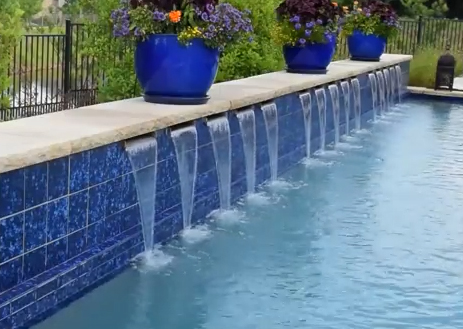ARTICLES
Advance Search
Aquatic Health
Aquatic Health, Fitness & Safety
Around the Internet
Aquatic Culture
Aquatic Technology
Artful Endeavors
Celebrity Corner
Life Aquatic
Must-See Watershapes
People with Cameras
Watershapes in the Headlines
Art/Architectural History
Book & Media Reviews
Commentaries, Interviews & Profiles
Concrete Science
Environment
Fountains
Geotechnical
Join the Dialogue
Landscape, Plants, Hardscape & Decks
Lighter Side
Ripples
Test Your Knowledge
The Aquatic Quiz
Other Waterfeatures (from birdbaths to lakes)
Outdoor Living, Fire Features, Amenities & Lighting
Plants
Ponds, Streams & Waterfalls
Pools & Spas
Professional Watershaping
Structures (Editor's Notes)
Travelogues & History
Water Chemistry
WaterShapes TV
WaterShapes World Blog
Web Links
Around the Internet
Aquatic Culture
Aquatic Technology
Artful Endeavors
Celebrity Corner
Life Aquatic
Must-See Watershapes
People with Cameras
Watershapes in the Headlines
When a pond's fish shift to spawning mode, all sorts of things start happening in a hurry -- in turn whipping new pond owners into a frenzy right alongside their fish. At these times, Mike Gannon counsels restraint and helps novices recognize and follow what's happening.
The first of this pair of articles mentioned that Julia Morgan had completed the architecture program at Beaux-Arts in Paris in three years rather than the usual five, but I didn't mention all of the circumstances. One of the rules of that institution prohibited the instruction of students after their thirtieth birthdays, which seems a totally bizarre limitation to us now but apparently made sense to French academicians at the turn of the 20th Century. Given the delays in her gaining a position at the school, she'd entered the program with the clock ticking and really had no choice but to
Safety is never far from my mind as I design for my clients, but as important as it is, it's seldom the only thing on my mind as a project comes together. In fact, balancing the need for features we must include for safety's sake with our everyday passion about never compromising on aesthetics is something I consider with every detail. Whether it's the extent to which
When we get involved in backyard projects, it's rare these days that we don't have a fairly high level of creative control: We're the ones who figure out where to place the pool, what shape it should have, how it should be finished and what should surround it with respect to the hardscape and landscaping and even the furnishings. That's why it's a bit funny that this is the second in a pair of projects we've recently published through WaterShapes in which many of the fundamental shots were called by others - in this case by a talented home-construction firm that brought us in after the footprint for the pool and spa had been
I've seen two articles recently that I must share - one inspiring, the other amazing. First the inspiration: It's tough for aquatic facilities to be recognized at all when it comes to the rigorous requirements of the
‘During a presentation to a recent conference for the swimming pool and spa industry, I tossed this nugget to the audience: “By a show of hands, how many of you in this room believe that most people think highly of our industry? Please be honest.” ’ That’s how Brian Van Bower began his Aqua Culture column in the May 2003 edition of WaterShapes. He continued: ‘It was a mixed group of more than 160 people representing
‘It’s an unfortunate fact that landscape architects receive little or no formal education in watershaping while they’re in school. As a result,’ began Mark Holden in his Currents column for the April 2008 issue of WaterShapes, ‘where the typical landscape architect’s irrigation plan will show every pipe, fitting, wire and component for a given project, that same project’s pool plan will carry almost no
I've recently returned from four days of celebrating the 20th anniversary of Genesis with friends and colleagues in Paso Robles, Calif. - about 35 miles away from where it all started for them at Morro Bay on the state's Central Coast. The weather wasn't as brilliant as it might have been, but everything else about the event was top notch and
When I wrote about Lawrence Halprin's Keller Fountain in Portland, Ore., in August 2012, I had meant to cover its Portland cousin, the Lovejoy Fountain, within a few months that have now turned into several years. Apologies for failing to double back sooner, because they really do fit together better than this span of time would suggest.
Lovejoy Plaza was the first completed installation in what is now known as the Portland Open Space Sequence, which includes four separate urban environments linked by promenades in a span covering eight blocks. Physically, Lovejoy Plaza is the second of the four spaces in the chain, which starts with the Source Fountain, moves past the Lovejoy Fountain, rolls through Pettygrove Park and ends up at the Keller Fountain.
Halprin was a pioneering advocate for this sequenced, themed approach to arranging urban spaces, and the fact that he became involved in Portland at a time of 1960s-style urban redevelopment gave him the opportunity to exercise his philosophy on a grand scale - and, more important, with a relatively clean slate.
The Lovejoy Fountain is a beautiful example of Halprin's aquatic work - varied elevations, expressive materials, dramatic contours, vigorous flows, wonderful sound. He's a master of mood management, in this case surrounding the fountain's rougher edges with plants and trees that soften its visual features and make the plaza more inviting. He's also a master of the art of engagement, providing all sorts of ways for passersby to get up close to the water and interact with it on multiple levels (this despite the fact that there are signs warning against coming in contact with it).
In this case as with several of his other designs, the Lovejoy Fountain is also a brilliant performance space - no surprise given Halprin's frequent collaborations with his wife, Anna, an accomplished performer who certainly encouraged him to look at public spaces as stages for dancers, backdrops for musicians and places for playful movement around the water. (One of the videos linked below put the fountain's artistic flexibility on brilliant display.)
The four spaces were designed between 1963 and 1970, with Lovejoy Plaza completed first, in 1966. Satoru Nishita served as partner-in-charge for the project after becoming a principal at Lawrence Halprin + Associates in 1964.
I like everything about this fountain, from its approachability to its reflection of nature and its debt to terrain I know well from my own time spent exploring the Columbia River Valley and the Sierra Nevada and Cascade ranges. It's manifestly a composed, artificial space, but it operates on a level where, like a great abstract painting, it gives observers the chance to run free with their own interpretations and responses.
If you can't tell by now, I'm a big fan of Mr. Halprin's work. The next time you're in the Great Northwest, spend an afternoon in downtown Portland and I think you'll see why.
To see an odd 360-degree video of the Lovejoy Fountain, click here and be sure to use the effect. It takes a while to get down to business, but it's worth the wait.
To see a video in which Lovejoy Fountain host an interactive art project, click here.
Among the best things about Philadelphia is its stock of public art - and that's not accidental: For many years, all construction projects in specific neighborhoods reaching certain dollar thresholds have been required to include an accessible work of art within their footprints. Whether it's a sculpture, a mural, a statue celebrating a Founding Father or a waterfeature, the city now boasts more than 1,000 of these art pieces, each one part of an outstanding cultural and historical landscape. One of our recent projects fit within this program: Located just across the way from Independence Hall, it's part of a




















